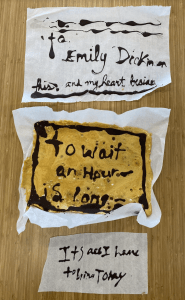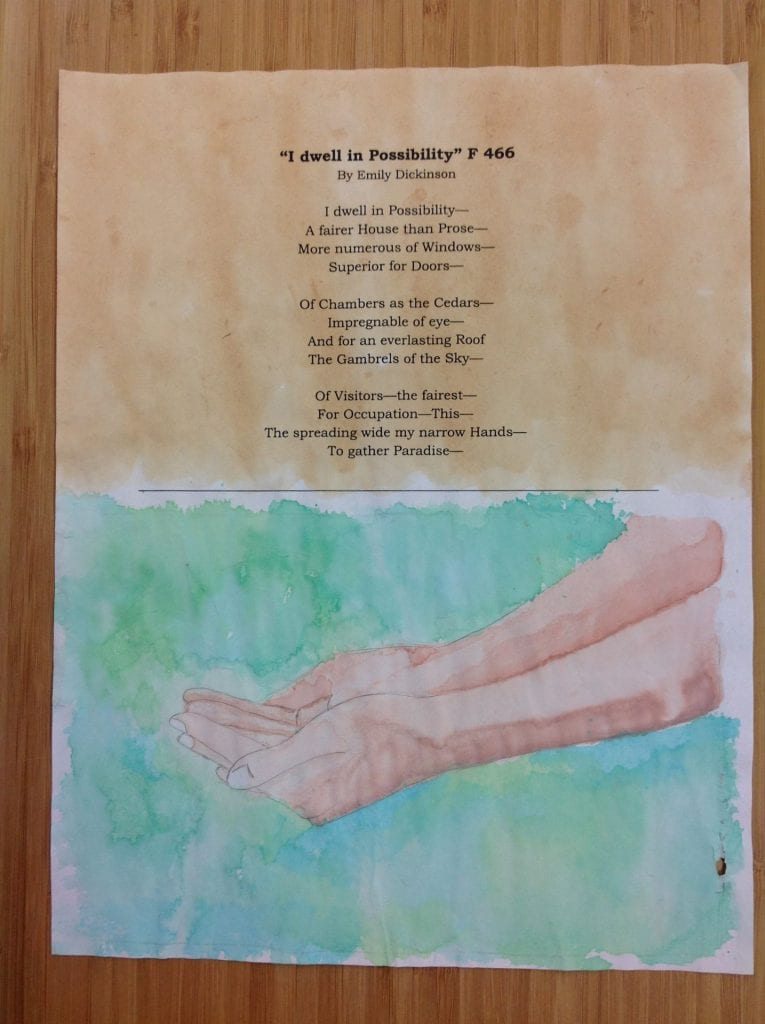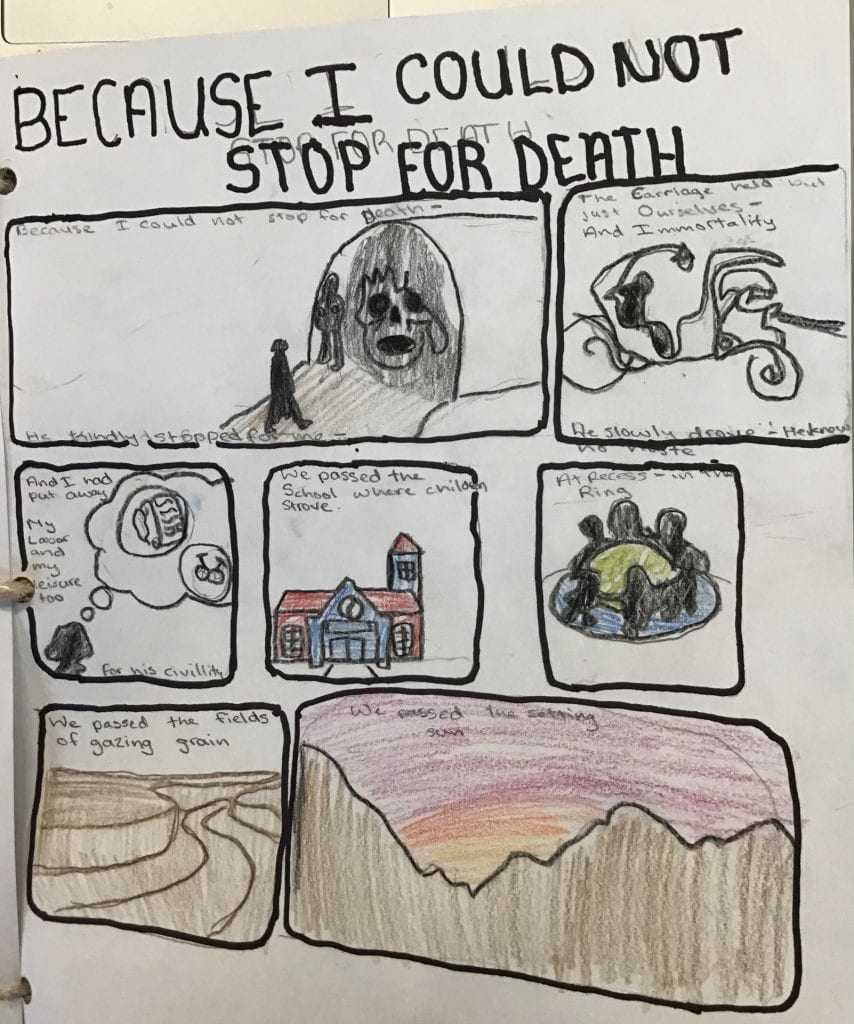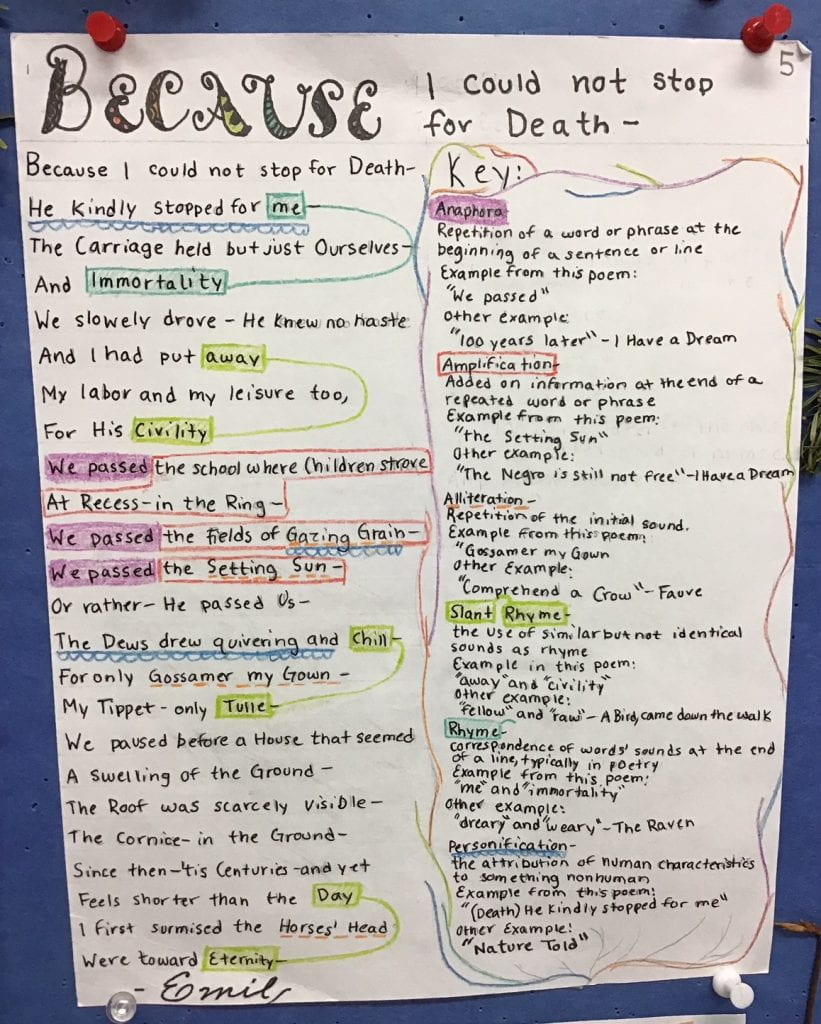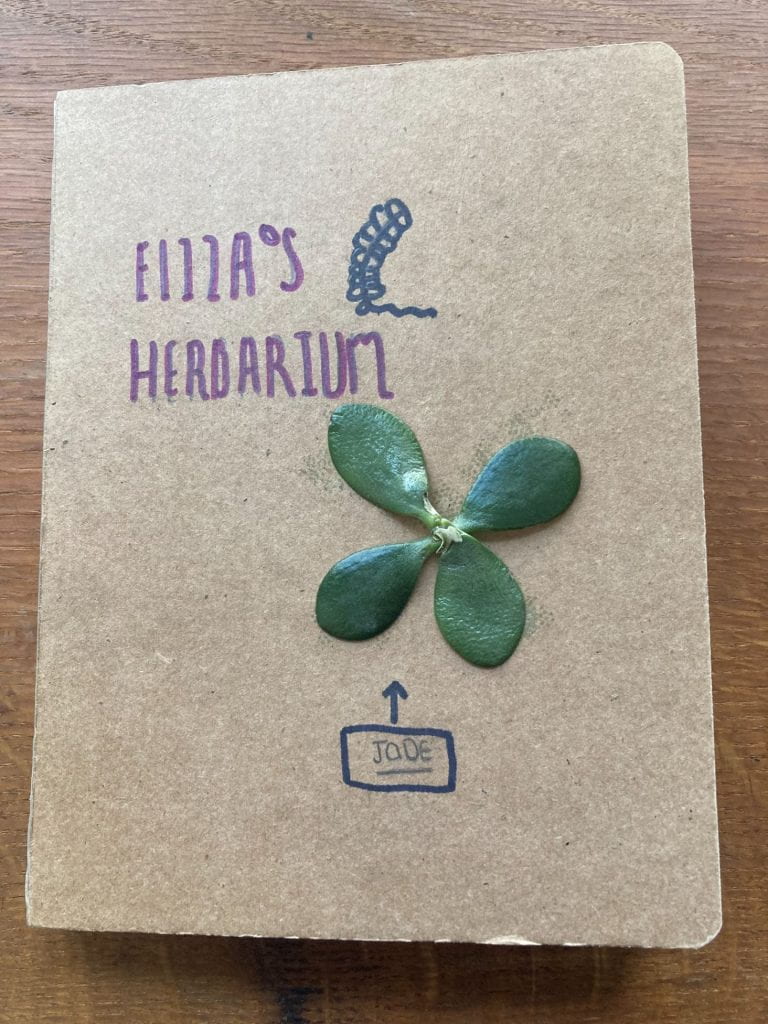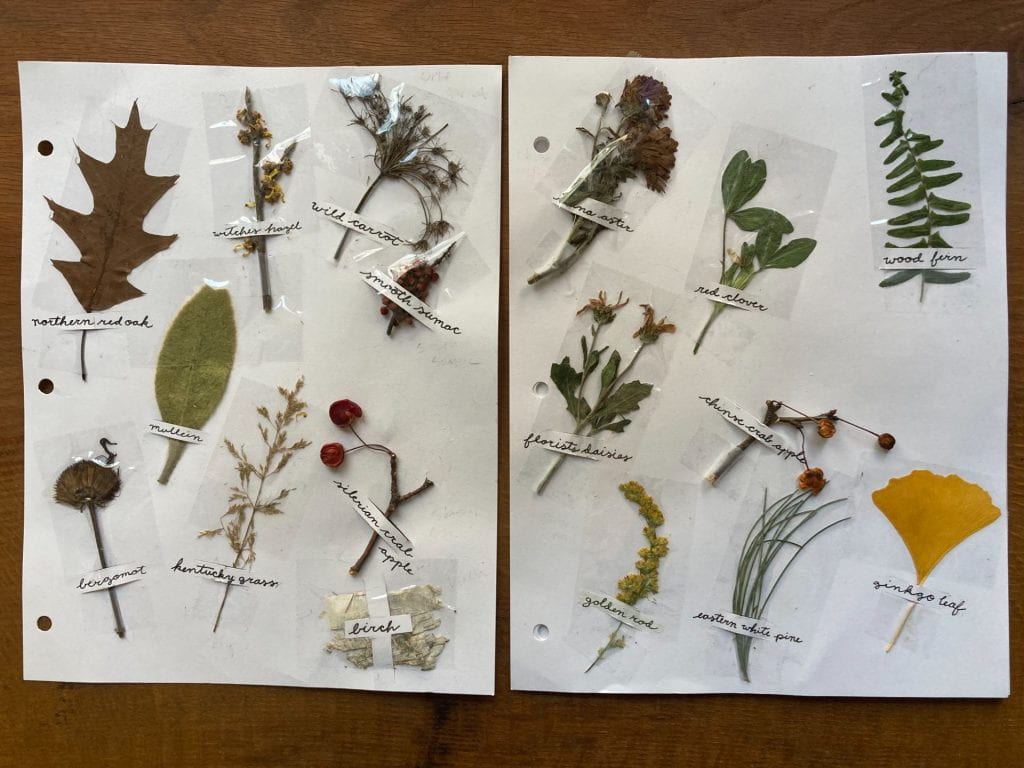On Choosing the Poems
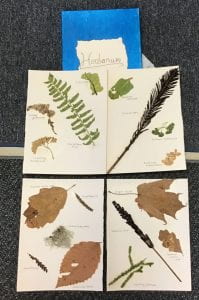
Since Fall 2018, we have been conducting our wonderful collaboration with Steve Glazer’s 7th grade class at Crossroads Academy in Lyme, NH. It started when, in Fall 2017, Dartmouth students from my junior colloquium, “New Emily Dickinson: After the Digital Turn,” visited Steve’s class and each chose a different digital tool to introduce to the middle schoolers. In the following years, I did the introductions (sometimes remotely). Steve begins the sessions with a group recitation of “In this short life” (F1291, J1287), the anthem of this class, as a means of encouraging students to appreciate Dickinson’s remarkable achievement, the opportunity this collaboration represents and access to digital projects like the Emily Dickinson Archive, which is available to them because of the work done by scholars dedicated to making Dickinson’s poetry more widely available.
Steve then goes around the room, inviting students to offer either a life fact about Dickinson, the definition of some poetic term they have learned, or first lines of her poems. No repetition allowed! Some spontaneous recitations of poems ensued. It is remarkable how much the students know about Dickinson. They know all about fascicles, hymn meter, and Dickinson’s life in Amherst. Some of them have read up to 500 of her poems!
To begin my presentation, I ask the students when they thought a poem was “finished” and ready for publication, and who decides that. This elicited some confused expressions and murmurs of, “I never thought of that.” I then summarize the complex history of the posthumous publication of Dickinson’s poems and explain the role of editors and what an “authoritative edition” is. Using the poem “Departed to the Judgment” (F 399A, J524), which I happened to be working on, I show them how to find the poem on the EDA and we struggle to make out Dickinson’s difficult handwriting. We also compare the manuscript facsimile, which allows us to see exactly what Dickinson herself wrote and copied into a fascicle, with its edited version in the 1890 Poems.
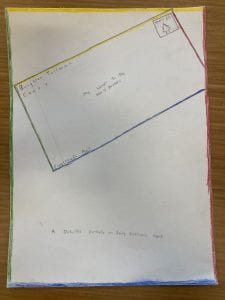
In the edited versions, the students are aghast to see titles, which they think generally reduces the poem’s complexity, and not to see Dickinson’s characteristic dashes, strange capitalizations, and idiosyncratic spelling. And in some cases, words changed, lines omitted or whole stanzas lopped off! We also explore the Dickinson Lexicon, and in “Departed to the Judgment,” see how the word “usher” means something different from what they expected. When I tell them that by using these digital tools, they can all become editors of Dickinson, deciding for themselves what constitutes “the finished poem,” their eyes light up. They thank me at the end of the class by singing “This is my letter to the World,” the title of this unit on Dickinson, to the tune of “Amazing Grace.” Singing the poem helps Steve introduce hymn meter and helps students memorize poems. It is remarkably moving. Here is the updated CrossroadsWorksheets 2023.
 Below is Steve’s description of his Dickinson project, “This is my Letter to the World,” which anyone is free to borrow, adapt and use in their classes. Note: you can get Steve’s contact information from the Crossroads Academy website under Faculty.
Below is Steve’s description of his Dickinson project, “This is my Letter to the World,” which anyone is free to borrow, adapt and use in their classes. Note: you can get Steve’s contact information from the Crossroads Academy website under Faculty.
SYLLABUS:
This is My Letter to the World, Fall 2018
Over the next 3-4 weeks, we will be working on “This is My Letter to the World,” a multi-genre Emily Dickinson portfolio project. Emily Dickinson is a unique voice in American poetry and letters. Hundreds of her poems were folded into letters—often accompanied by leaves or pressed flowers—and offered as generous gifts to her friends. The poet’s writing returns again and again to her core themes: nature, love, loss, faith, and time.
By the end of this project you will
1. Demonstrate your understanding of Emily Dickinson’s poetry by:
• Completing the Emily Dickinson web quest. Students construct a biography of the poet by navigating the Emily Dickinson Museum’s website.
• Reading at least 25 Emily Dickinson poems
• Reading and taking Cornell notes from at least one scholarly essay
• Submitting a detailed structural analysis of one significant Dickinson poem
• Composing a 1-2 page “close reading” of a second major poem
• Completing an “Emily Dickinson in 1862” blog post, potentially for White Heat. Select a poem from 1862 and choose ONE method of engagement:
A) memorize/recite this poem
B) analyze/illuminate this poem
C) compose a brief 2-3 paragraph response to the poem
D) research/take notes on scholarly research
E) create an artistic response (art, music, dance, film, etc.)
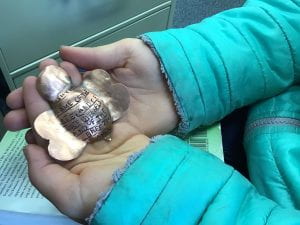
F) construct a poster, power point, or webpage
• Memorizing and reciting at least three Dickinson poems (“In this short life,” “This is my letter to the world,” and one other)
2. Replicate Emily Dickinson’s approach to composition by:
• Composing at least two poems to demonstrate your familiarity with Dickinson’s style
• Constructing an herbarium of leaves, pressed flowers, seeds, etc.
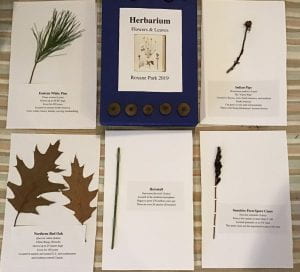
• Writing a letter to a family member, friend, teacher, or mentor that includes: (a) a salutation; (b) a brief introduction to our unit and the life of Emily Dickinson; (c) your favorite Dickinson poem; (d) an introduction to your own poem; and (e) a copy of your poem. Pressed leaves or flowers are optional.
Your final product will be your “Letter to the World” portfolio:
1. DESIGN: An artistic cover page & an accurate table of contents – 8 pts
2. WEBQUEST: A neat & complete worksheet – 8 pts
3. READING: A typed list of the poems you’ve read (MLA formatted first line + Franklin number) – 8 pts
4. SCHOLARLY ESSAY: Submit the title and author of the essay along with your Cornell notes – 8 pts
5. LITERARY ANALYSIS: A neat presentation of one analyzed poem, demonstrating your understanding of poetic form, rhyme scheme, poetic meter, assonance, alliteration, & other rhetorical devices – 10 pts
6. RESPONSE TO LITERATURE: A 1+ page typed response/reflection to a favorite Dickinson poem – 10 pts
7. BLOG POST: Your response to one of ED’s poems from 1862 – 10 pts
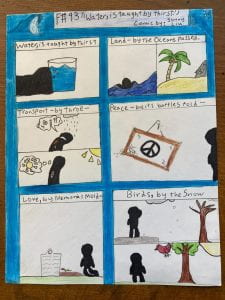
8. CREATIVE WRITING: Copies of your original poems written in the style of Emily Dickinson – 10 pts
9. HERBARIUM: Includes at least ten native species – 4 pts
10. LETTER WRITING: A copy of your letter, as outlined above
– 10 pts
11. RECITATION: Your performance of the Dickinson poems you have memorized – 8 pts
12. BONUS: Awarded for additional &/or exemplary work: reading, writing, analysis, memorization, or creative response (visual art, musical performance, dance/movement, etc.) – 6 pts
Total ___/100 pts
You are welcome (and encouraged) to submit your project components early, as each piece is completed, so that you can revise and improve your work!
 *****
*****
This week, we include several responses by the Crossroads students, and though we are not allowed to reveal their identities, we are so thankful to them for their participation and creativity. In several cases, they selected poems that have already appeared in a post, so we provide links to that. Some are very special such as this this Google Earth tour of Dickinson’s world.
The Moon is distant from the Sea (F387, J429)
The Moon is distant from
the Sea –
And yet, with Amber Hands –
She leads Him – docile as a Boy –
Along appointed Sands –
He never misses a Degree –
Obedient to Her eye –
He comes just so far – toward
the Town –
Just so far – goes away –
Oh, Signor, Thine, the Amber
Hand –
And mine – the distant Sea –
Obedient to the least command
Thine eye impose on me –
Link to the poem on the post on Astronomy.
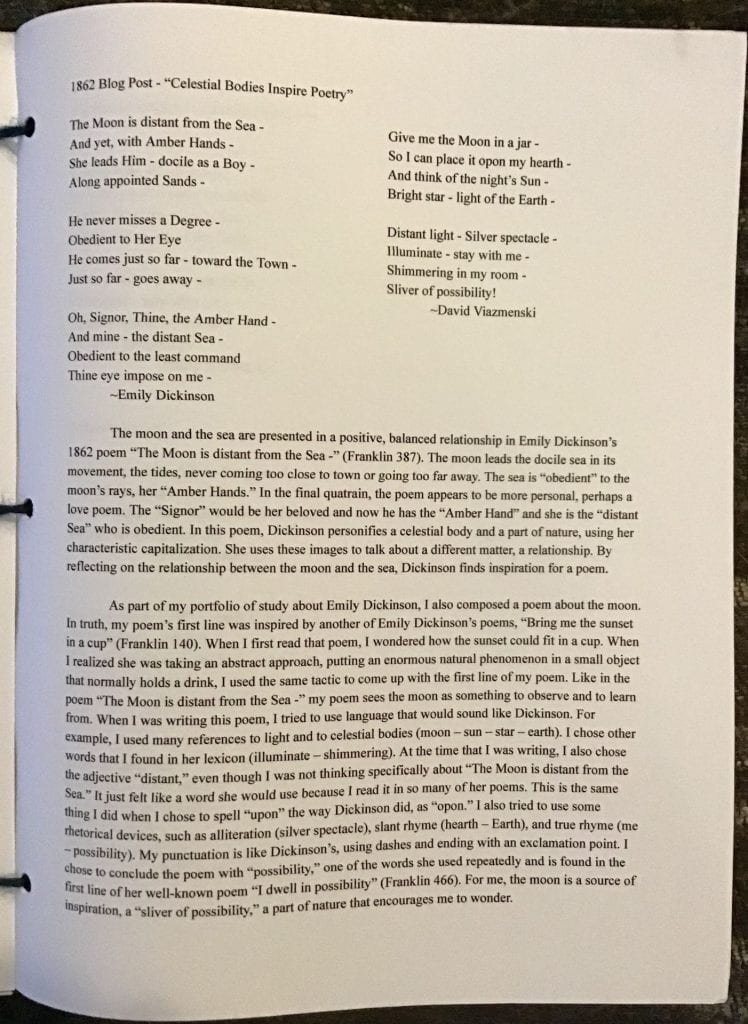
Original Film by Crossroads student in 2018:
They Shut me up in Prose (F445, J613)
They shut me up in Prose –
As when a little Girl
They put me in the Closet –
Because they liked me "still" –
Still! Could themself have peeped –
And seen my Brain – go round –
They might as wise have lodged
a Bird
For Treason – in the Pound –
Himself has but to will
And easy as a Star
Look down opon Captivity –
And laugh – No more have I –
Link to the poem on the post on Women of Genius
Video of Recitation by Crossroads Student, 2018:
I dwell in Possibility (F466, J657)
I dwell in Possibility –
A fairer House than Prose –
More numerous of Windows –
Superior – for Doors –
Of Chambers as the Cedars –
Impregnable of eye –
And for an everlasting
Roof
The Gambrels of the Sky –
Of Visitors – the fairest –
For Occupation – This –
The spreading wide my
narrow Hands
To gather Paradise –
Link to the poem on the post on Women of Genius
Project from Crossroads Academy, 2020
An illustration by I.
Project from Crossroads Academy, 2018
Because I could not Stop for Death (F479, J712)
Because I could not
stop for Death –
He kindly stopped for me –
The Carriage held but
just Ourselves –
And Immortality.
We slowly drove – He
knew no haste
And I had put away
My labor and my leisure
too,
For His Civility –
We passed the School,
where Children strove
At Recess – in the Ring –
We passed the Fields
of Gazing Grain –
We passed the Setting Sun –
Or rather – He passed
Us –
The Dews drew quivering
and Chill –
For only Gossamer, my
Gown –
My Tippet – only Tulle –
We paused before a
House that seemed
A Swelling of the Ground –
The Roof was scarcely
visible –
The Cornice – in the Ground –
Since then – 'tis Centuries -
and yet
Feels shorter than the Day
I first surmised the
Horses' Heads
Were toward Eternity –
Link to the poem on the post on the Azarian School
Project from Crossroads Academy, 2020
A graphic illustration by L.
Projects from Crossroads Academcy, 2019
Video of original booklet created by Crossroads student in 2019
They Dropped like Flakes (F545, J409)
They dropped like Flakes –
They dropped like stars –
Like Petals from a Rose –
When suddenly across the June
A Wind with fingers – goes –
They perished in the seamless Grass –
No eye could find the place –
But God can summon every face
On his Repealless – List.
Link to the poem on the post on the Civil War
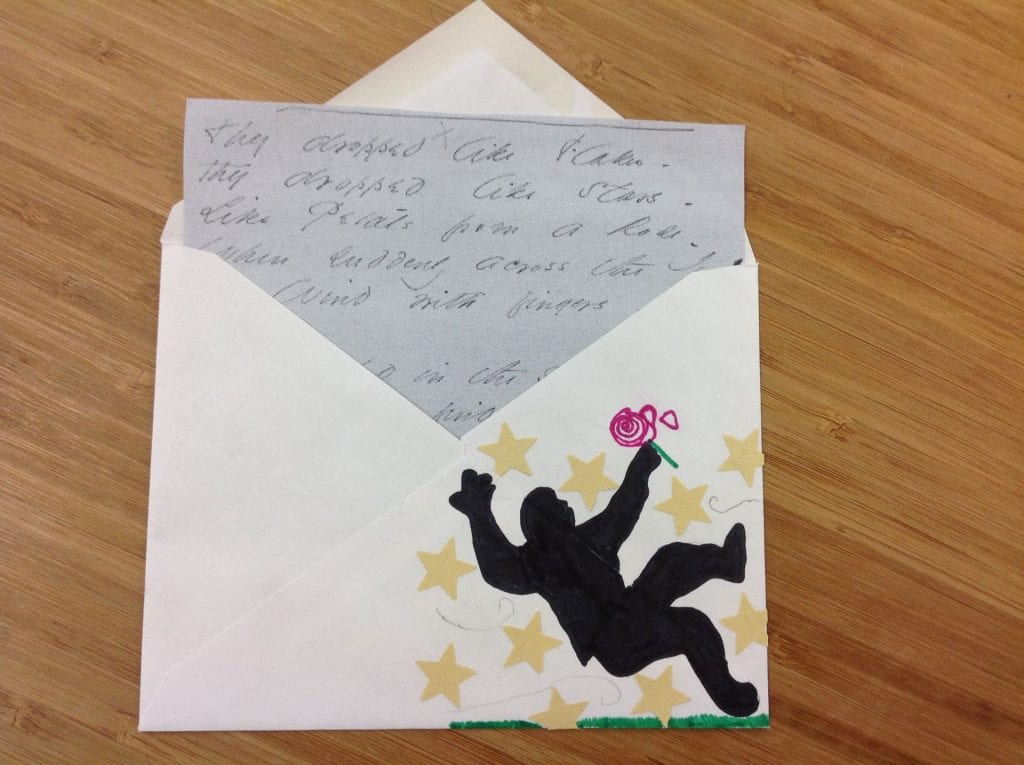
And a related poem and project for "It feels a shame to be alive" (F524, J444)
[caption id="attachment_7000" align="alignleft" width="225"]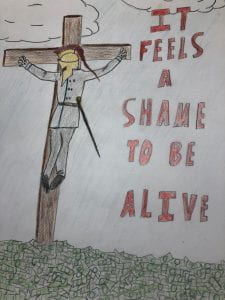 Image by Crossroads student, 2019
Image by Crossroads student, 2019
Much Madness is divinest Sense (F620, J435)
Much Madness is divinest Sense –
To a discerning Eye –
Much Sense – the starkest
Madness –
'Tis the Majority
In this, as all, prevail –
Assent – and you are sane –
Demur – you're straightway dangerous –
And handled with a Chain –
Link to poem in post on School

3 Fascicles of Emily Dickinson's epigrams.
Steve Glazer explains this extraordinary project:
The Crossroads student discovered Dickinson's epigrams through William H. Shurr's New Poems of Emily Dickinson, which I checked out from Dartmouth College Library. (I checked out a dozen books so the students could bring Dickinson's work home during the project.)
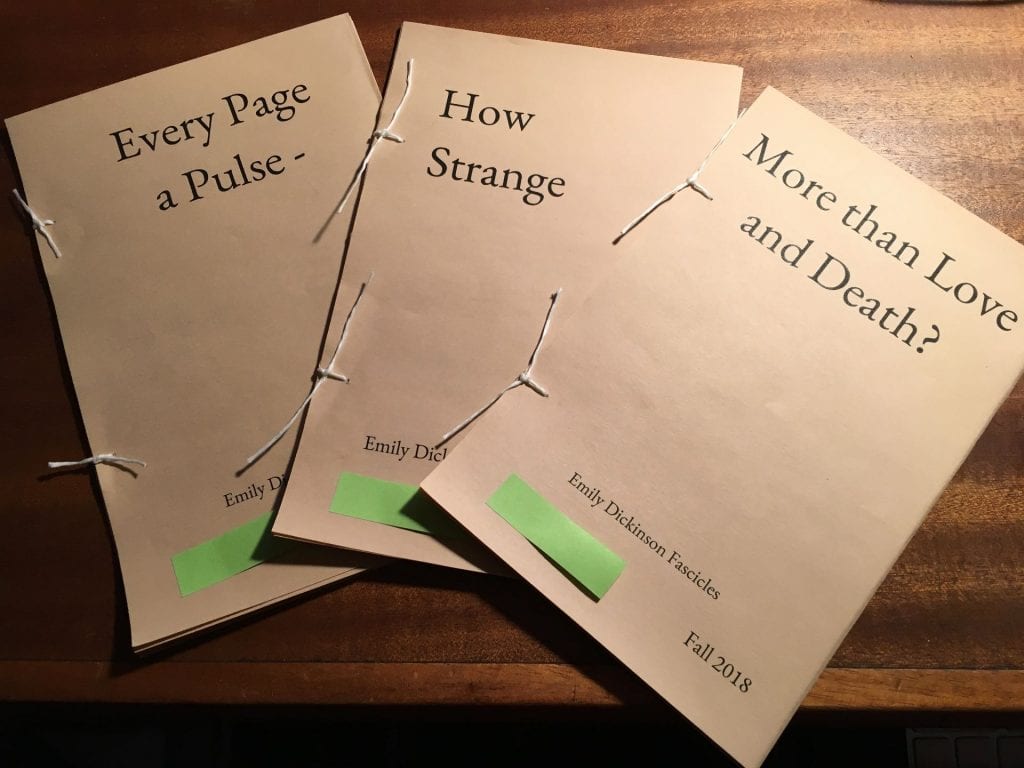
“Emily's Wings” by Crossroads students in 2019, lines from Dickinson's poems set to the song “Angel by the Wings” by Sia and performed in the Evergreens' salon, at the Emily Dickinson Museum.
The wind begun to knead the grass (F796A, J824)

The Wind begun
to knead the
Grass -
As Women do a
Dough -
He flung a
Hand full at the
Plain -
A Hand full at
the Sky -
The Leaves unhooked themselves from Trees -
And started all
abroad -
The Dust did
scoop itself like
Hands -
And throw away
the Road -
The Wagons quick -
ened on the Street -
The Thunders gossiped
low -
The Lightning showed
a Yellow Head -
And then a livid
Toe -
The Birds put up
the Bars to Nests -
The Cattle flung
to Barns -
Then came one
drop of Giant Rain -
And then, as if
the Hands
That held the
Dams – had parted
hold -
The Waters Wrecked
the Sky -
But overlooked
my Father's House -
Just Quartering
a Tree -
Herbariums, by Crossroads Academy students, 2022
Mia2023ED Scholarly Essay Cornell Notes
Constance Rooke, “‘The First Day’s Night Had Come’: An Explication of
J.410/F.423,”
Cornell Notes & Blog Post
|
Title |
“An Explication of ‘The first Day’s Night had come’” |
|
Genre of Poem |
“[A] lyric projected as a drama” (80). |
|
Time |
● Starts on the first day of the narrator’s new life. ○ “[W]holly formed as the aftermath of “a thing / So terrible” that it made a radical discontinuity in the life and personality of its endurer” (80-81). |
|
Tone of Voice? |
“[C]rucially ironic and naked at the same time;” (81). |
|
Simple Context |
● Characters are created inside the speaker, by the speaker, for the purpose of fixing or deconstructing a painful future. ○ Though, the actions they are commanded to do are meant to be performed in, “dialogue and protective, ironic gesture” (81). |
|
First Stanza |
The first Day’s Night had come– And grateful that a thing So terrible–had been endured– I told my Soul to sing– |
|
What’s So Terrible? |
● Presents itself to the reader’s imagination. ○ It could be anything ■ Loss of lover ■ Psychosis ■ Heart Failure ■ Menstruation |
|
Problematic Questions |
● “Is it likely that she should be grateful for only this brief and bare endurance? And out of what mood, given the situation, does one tell one’s soul to sing?” (81). ○ She could be grateful that, in any way, she survived what has come so far. ○ Or, talking to her own soul may be the start of a, “mad game” (81). ○ “Her gratitude may be a mocking of her own deprivation . . .” (81).
|
|
Telling Her Soul to Sing? |
● “Souls, furthermore, do not ordinarily need to be commanded into song; they are supposed to do that spontaneously” (81). ○ “[H]er order to the soul a grim recognition that free song is past” (81). |
|
Second Stanza |
She said her Strings were snapt— Her Bow—to Atoms blown— And so to mend her–gave me work Until the next Morn |
|
Personified Soul |
● “[P]oet’s toy” (81). ○ As an effort to stay in anguish |
|
Was the soul put together by the next morning? |
“It is a tidy little image for such an ultimate task, its limitations suggesting a patchwork job at best” (81). |
|
Third Stanza |
And then—a Day as huge As Yesterdays in pairs, Unrolled its horror in my face— Until it blocked my eyes— |
|
Did the work pay off? |
● “If she had thought her night work effective, she rose to find it far otherwise” (81-82). |
|
Dollmaker and Doll Soul |
● Tried to govern her pain with minimal “patchwork” ○ “[W]ithin the play world established between herself and a doll soul” (82). ■ “But daylight brought monstrous twins to threaten the dollmaker” (82). |
|
“Yesterdays” |
● No possessive apostrophe ○ Allows the day to be seen as pairs. |
|
Malicious Footmen |
“Perhaps as malicious footmen, giants who unroll their horror as if at the start of a carpet which will only be unwound at her life’s end” (82). |
|
Duplication of Pain? |
● Bad on the first day, then “fixed”, then really bad the next. ○ “each day will it be twice as bad as the day before?” (82). |
|
Blocked Eyes |
“She is so appalled by the vision of her anguished situation that her eyes are blocked and she turns inward” (82). |
|
Fourth Stanza |
My Brain—begun to laugh— I mumbled—like a fool— And tho’ ‘tis Years ago— that Day— My Brain keeps giggling—still. |
|
Why is the Brain Laughing? |
● Laughter turns on after the shock of withdrawal. ○ It could be another person laughing in a way, “to reveal the prison and foolishness of struggle” (82). ■ “The sickened brain, bereft of intellectual power by this departure from reality, diverges from the speaker to become a separate character” (82). |
|
Giggling and Mumbling |
● The narrator’s speech is “reduced to mumbling in the face of the brain’s superior laughter” (82). ○ In a way, she “mumbled” the brain character into existence and created her own tormentor. |
|
“—like a fool—” |
● Pertains to laughing and mumbling ○ “[U]ltimately to the schizophrenic retreat which deprives her of reality and the faint hope of renewal” (82). |
|
Years later |
The laughter is gone, but there are still a few giggles, and the hideous joke persists. |
|
Fifth Stanza |
And Something’s odd—within— That person that I was— And this One—do not feel the same— Could it be Madness— this? |
|
“That person that I was” |
● The person mentioned is remote. ○ There’s a vague remark of the fact that “Something’s odd”, and the pause before saying “within” gives a hint that she is afraid to admit that she is who was mentioned before. ■ “[A] distinction no longer valid” (82). ● It suggests, “the seriousness of her discontinuity. ● There’s also, “a childishness in her expression of the sense that these two persons do not feel the same” (82-83). |
|
Madness |
● The narrator is fading out now. ○ Pretty good sign of madness. ○ The reader’s horror is most likely greater at this point than any other where the narrator still wrestles with her demons. |
Works Cited
Constance Rooke, “‘The First Day’s Night Had Come’: An Explication of
J.410/F.423,” Emily Dickinson Bulletin, vol. 24 (1973).


